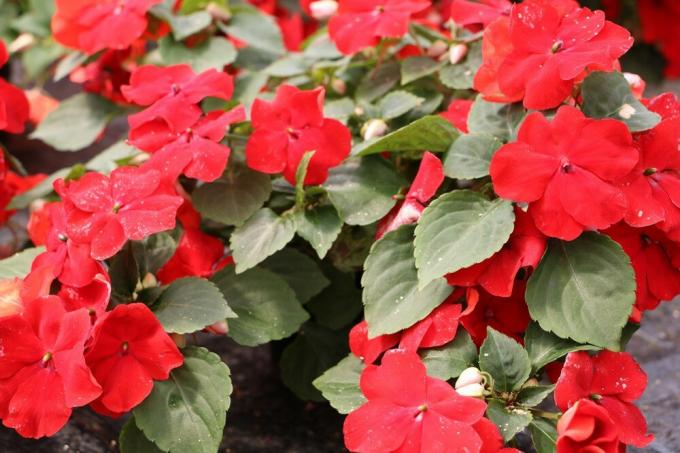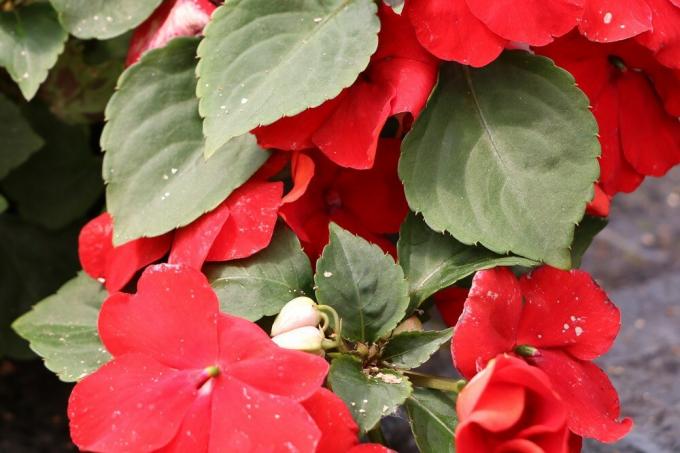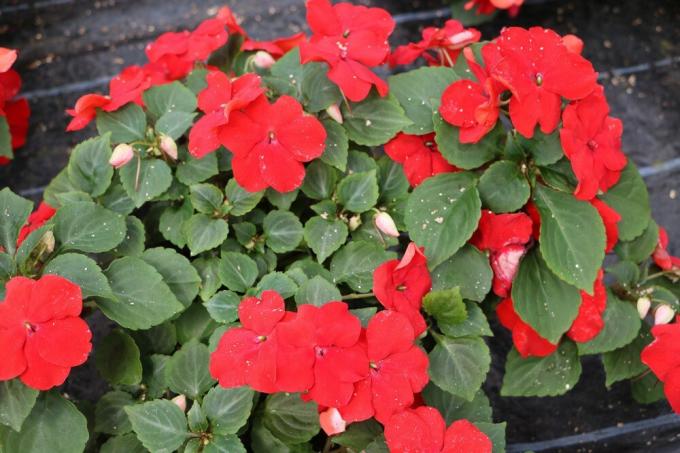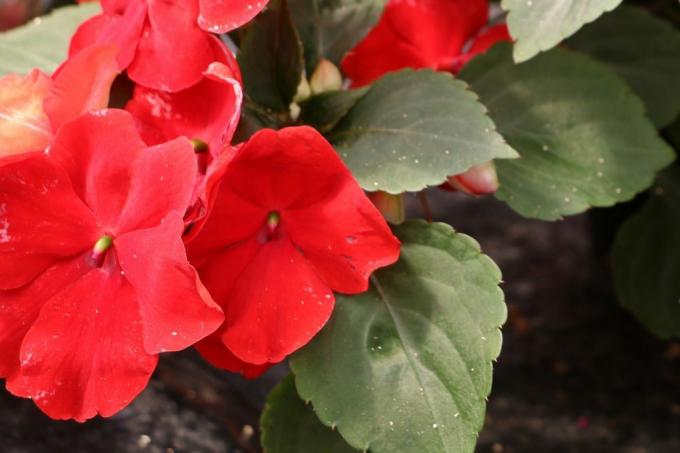
table of contents
- Origin & growth
- care
- Location
- to water
- Fertilize
- Overwinter
- Multiply
- Pests
- Diseases
- sorts
Profile and care information open +conclude -
- Flower color
- orange, pink, red, violet, white
- Location
- Partial shade, no sun
- Heyday
- May, June, July, August, September, October
- Growth habit
- upright, annual
- height
- 20 to 40 cm
- Soil moisture
- moderately moist, fresh
- PH value
- neutral, slightly acidic, acidic
- Limescale tolerance
- Calcium tolerant
- humus
- rich in humus
- Poisonous
- no
- Plant families
- Balsam family, Balsaminaceae
- Plant species
- Balcony flowers, balcony plants, garden plants, container plants
- Garden style
- Flower garden, pot garden
The industrious Lieschen is an extremely popular guest in flower beds, balcony boxes, hanging baskets and pots at home. The decorative ornamental plant blooms long and intensively and rewards good care with a veritable sea of flowers. The care instructions explain everything you need to know about keeping the Impatiens properly and appropriately walleriana and shows how you can optimize growth and flowering with little effort can promote.
Origin & growth
The hardworking Lieschen lives up to its name: The comparatively easy-care ornamental plant blooms continuously and extremely diligently throughout the summer until the beginning of autumn. Countless, close together flowers in bright colors cover the bushy growing Impatiens walleriana and set a colorful contrast to the lush green foliage.
The frost-sensitive plant comes from the east and southeast of Africa and usually grows as an annual. In the care instructions you will find out under what conditions it will thrive and develop most of the flowers.

The Impatiens walleriana came at the end of the 19th Century from East and Southeast Africa to Europe. Today balconies, terraces and gardens can no longer be imagined without it, with its splendor of flowers.
care
The maintenance effort of the Impatiens walleriana is manageable. If you pay attention to a few aspects of care, you will have great pleasure in the flowering ornamental plant during summer and autumn.
Location
The Impatiens walleriana prefers light shade or partial shade. Direct sunlight causes burns on the sensitive plant, but a location that is too dark inhibits flower formation. The location should also be protected from the wind. Temperatures between 20 ° C and 24 ° C promote growth best.
Substrate
Hard-working lizards thrive in a loose, humus-rich and well-drained substrate. Regular potting soil is usually sufficient. A less nutrient-poor soil can be enriched with some compost to improve permeability and nutrient content.
plants
The hard-working Lizzie is considered a summer flower and is sensitive to cold, which is why it can only be planted after the last frost. It is best to plant the Lizzie in the ground from mid-May. Particularly healthy and strong specimens that have already developed the first flowers are recommended here.
Several plants are used at a distance of 20 to 30 cm. If you want to plant your Impatiens walleriana in a pot or box, you should not choose a container that is too large. In smaller pots, the roots are closer together, which means that the plant will produce more flowers.

to water
The hardworking Lieschen has a very high water requirement. In Switzerland, the thirsty plant is therefore also nicknamed Süüfferli. The substrate should always be kept slightly moist. Water the Impatiens walleriana regularly with little water, as it does not tolerate drought or waterlogging.
For balcony and potted plants, a permeable pot should therefore be used so that excess water can drain off. If the temperatures rise above 25 ° C for a long time, the tender leaves can suffer from the heat. Here it is advisable to spray the plant with a little water. The flowers should be avoided if possible.
Fertilize
Since the Impatiens walleriana is sensitive to too much fertilizer, it is sufficient if you give it some liquid fertilizer every two weeks. A low-dose product is recommended. This also stimulates the joy of flowering.
After flowering
Wilted flowers can be plucked off. This stimulates the growth of new flowers. When the Impatiens walleriana has completely faded, it can be removed from the ground and disposed of in organic waste or composted.
Overwinter
The hard-working Lieschen is usually cultivated as an annual plant. However, ambitious hobby gardeners can try to let the frost-sensitive plant overwinter in the house and thus extend its lifespan by another year. Many Impatiens walleriana even continue to bloom in their winter quarters.

As soon as the outside temperature drops to 10 ° C or less over the long term, the plant must be brought inside. This is usually the case in September. Bedding plants are dug up and potted, while pots, window boxes and the like can be moved to the winter quarters as they are.
The ornamental plant has a good chance of surviving the winter under the following conditions:
- it needs a bright location
- the basement or other dark places are unsuitable
- the room does not need to be heated, but should be warmer than 10 ° C
- a temperature between 10 ° C and 15 ° C is optimal
- the Impatiens walleriana should not be fertilized during hibernation
- it only needs to be poured moderately
For example, the following are suitable as bright, cool winter quarters:
- a winter garden
- A floor
- a stairwell
- a window sill
From mid-May, when the temperatures no longer permanently drop below 10 ° C, the Impatiens walleriana can be put outside again. It should best be repotted or to be planted in a bed. The fresh substrate promotes the new development of the hard-working Lieschen.
Multiply
In the spring, strong young Impatiens wallerianas can be bought in specialist gardeners, discounters and many other dealers at low prices. If you still want to grow your own hard-working lizards, you have two options: seeds and cuttings. In May of the following year, the offspring bred in this way are put outside in a pot or in a bed.
Seeds
The Impatiens walleriana forms seed pods that are 1.5 to 2 cm in size. As soon as it is ripe, the light green capsule immediately pops open with a light touch and spreads its seeds explosively in the environment. If you want to breed hardworking lizards yourself, you must therefore proceed carefully. It is best to harvest the seed pods shortly before they are ripe.

To do this, you quickly and completely encircle the capsule with your hand and then separate it from the plant. So that they can ripen, the seeds are placed in a tall, open container and placed in a warm and dry place in the house.
sowing
Harvested or purchased seeds are sown between February and March. To do this, fill a pot with potting soil and place the seeds on it. They must not be covered with substrate because Impatiens walleriana is a light germ. The best thing to do is to put the pot on a windowsill. The seeds germinate fastest at temperatures between 16 ° C and 18 ° C.
Cuttings
The vigorous Impatiens walleriana can also be propagated using offshoots.
- separate a shoot from the mother plant
- remove all the leaves in the lower third
- fill a small pot with some potting soil and place the cutting in it
- water the cutting and always keep the soil slightly moist
- place the pot in a bright place, ideally with morning or evening sun
The pot is then covered with a transparent hood, for example a small plastic bag. This creates a warm, humid climate that stimulates growth. The substrate is also kept evenly moist in this way, which is also recommended. After about three to four weeks, when the first fine roots have formed, the cover can be removed.
Alternatively, the cutting can be grown in an indoor greenhouse. In principle, the hard-working Lieschen can be propagated all year round with the help of cuttings. However, autumn is best for removing shoots, as the cuttings then have time to grow until spring.
Pests
The robust Impatiens walleriana is relatively insensitive to pests. Above all, if care errors such as too much water it can lead to infestation, which can be easily removed in most cases.

Aphids
The aphid, one of the most common pests in gardens, does not stop at the Impatiens walleriana either. The insects, which are just a few millimeters in size, are usually located on the underside of the leaves and can be seen with the naked eye. An infestation is also noticeable through sticky honeydew.
The affected plant should immediately be thoroughly and from all sides using Nettle manure or a solution of water and curd soap. You should repeat the treatment after two to three days. Repeat the process until no more aphids can be seen.
Red spider
If the Impatiens walleriana is too warm and in too dry air for a long time, it can be attacked by red spiders. The pests, which are around 0.6 mm in size, can usually only be seen with a magnifying glass.
They are noticeable through the following symptoms:
- the leaves are covered with a fine web
- small bright spots appear
- later the leaves turn yellow, then brown and wither
First, spray the plant with lukewarm water to rinse off some of the red spiders. Then spray the busy Lieschen with a commercially available plant protection spray. Repeat the treatment after two weeks.
Diseases
Young plants are occasionally attacked by the falling sickness. It is caused by soil fungus that kill the hardworking lizy. Affected plants can no longer be saved. Before you plant a new crop in the ground, you should treat it with fungicides or dig out a large area of the soil and replace it with fresh substrate.
You can prevent falling sickness with the following measures:
- use seeds dressed with fungicides
- do not place the young plants too close together in the ground
- avoid waterlogging
- the Impatiens walleriana does not have to be watered again until the top layer of soil is dry
- poorly drained soils also favor the spread of harmful fungi
- if necessary, enrich the substrate with compost
sorts
The wealth of varieties and the different cultivated forms contribute to the popularity of the hardworking Lieschen - over 1000 varieties are known worldwide. They differ mainly in terms of the color, abundance and shape of their flowers. Here is an overview of the most popular Impatiens walleriana.
Impatiens walleriana Victorian Rose
With its semi-double flowers in dark red and pink tones, the Victorian Rose variety is vaguely reminiscent of roses. The ornamental plant grows up to 20 cm high and has dark green leaves.
Impatiens walleriana Blackberry Ice
The Blackberry Ice variety is characterized by its double flowers in an intense fuchsia color. Some of the green leaves have a decorative yellow border. The plant grows up to 30 cm high.
Impatiens walleriana Candy (series)
Impatiens walleriana Candy scores with particularly large flowers with five petals each. This compact growing variety is a series that includes several cultivated forms with different flower colors. Busy lizards of the Candy variety bloom in red, white, purple, pale pink, orange, salmon and neon orange.
Impatiens walleriana Tempo (series)
Another series is the Tempo variety. This Impatiens walleriana grows particularly bushy and is up to 25 cm high. Its unfilled flowers include white, orange, red, and pink, among others. Some cultivars in the Tempo series have two-tone petals.
Impatiens walleriana of the Fiesta (series)
The hardworking lizards of the Fiesta series have lush flowers that are double and ruffled. This series is also characterized by its variety of colors: The various cultivated forms bloom in red, pink and rose, among others. The variety grows like a carpet and reaches a maximum height of 40 cm.
Impatiens walleriana Elfin
The Elfin variety is a cultivated form with unfilled flowers that shine particularly intensely. In addition to red, white, rose, salmon and pink flowers, there are also multicolored specimens. The ornamental plant grows up to 25 cm high and was bred in Costa Rica.



